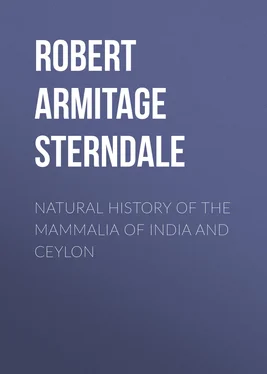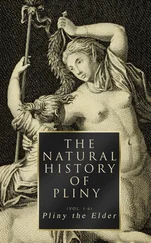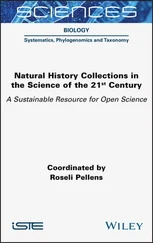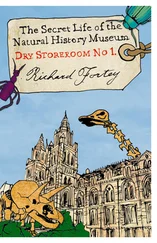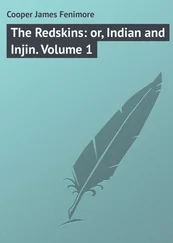Robert Armitage Sterndale - Natural History of the Mammalia of India and Ceylon
Здесь есть возможность читать онлайн «Robert Armitage Sterndale - Natural History of the Mammalia of India and Ceylon» — ознакомительный отрывок электронной книги совершенно бесплатно, а после прочтения отрывка купить полную версию. В некоторых случаях можно слушать аудио, скачать через торрент в формате fb2 и присутствует краткое содержание. Жанр: foreign_edu, Биология, на английском языке. Описание произведения, (предисловие) а так же отзывы посетителей доступны на портале библиотеки ЛибКат.
- Название:Natural History of the Mammalia of India and Ceylon
- Автор:
- Жанр:
- Год:неизвестен
- ISBN:нет данных
- Рейтинг книги:5 / 5. Голосов: 1
-
Избранное:Добавить в избранное
- Отзывы:
-
Ваша оценка:
- 100
- 1
- 2
- 3
- 4
- 5
Natural History of the Mammalia of India and Ceylon: краткое содержание, описание и аннотация
Предлагаем к чтению аннотацию, описание, краткое содержание или предисловие (зависит от того, что написал сам автор книги «Natural History of the Mammalia of India and Ceylon»). Если вы не нашли необходимую информацию о книге — напишите в комментариях, мы постараемся отыскать её.
Natural History of the Mammalia of India and Ceylon — читать онлайн ознакомительный отрывок
Ниже представлен текст книги, разбитый по страницам. Система сохранения места последней прочитанной страницы, позволяет с удобством читать онлайн бесплатно книгу «Natural History of the Mammalia of India and Ceylon», без необходимости каждый раз заново искать на чём Вы остановились. Поставьте закладку, и сможете в любой момент перейти на страницу, на которой закончили чтение.
Интервал:
Закладка:
The teeth in some degree resemble Erinaceus , the molars and premolars especially, but the number in all is greater, there being forty-four, or eight more. It would be interesting to know whether the zygomatic arch is perfect and the tibia and fibula united, as in the hedgehogs, or wanting and distinct as in the shrews. I have given a slight sketch in outline of the animal.
HABITAT.—Tenasserim (Sumatra, Borneo); Malacca.
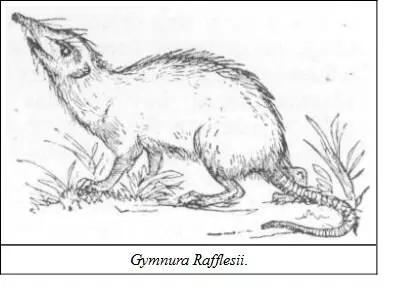
DESCRIPTION.—Long tapering head, with elongated muzzle, short legs, shrew-like body, with a long, round, tapering and scaly rat-like tail, naked, with the exception of a few stiff hairs here and there among the scales. In each jaw on each side three incisors, one canine (those in the upper jaw double-fanged) and seven premolars and molars; feet five-toed, plantigrade, armed with strong claws. Fur of two kinds, fine and soft, with longer and more spiny ones intermixed. The colour varies a good deal, the general tint being greyish-black, with head and neck pale or whitish, and with a broad black patch over the eye. Some have been found almost wholly white, with the black eye-streak and only a portion of the longer hairs black, so that much stress cannot be laid on the colouring; the tail is blackish at the base, whitish and compressed at the tip. Mr. Blanford says: "The small scales covering the tail are indistinctly arranged in rings and sub-imbricate; on the lower surface the scales are convex and distinctly imbricate, the bristles arising from the interstices. Thus the under surface of the tail is very rough, and may probably be of use to the animal in climbing." He also refers to the fact that the claws of his specimen are not retractile, and mentions that in the original description both in Latin and English the retractability of the claws is pointed out as a distinction between Gymnura and Tupaia . In the description given of the Sumatran animal both by Dallas and Cuvier nothing is mentioned about this feature.
SIZE.—A Sumatran specimen: head and body, 14 inches; tail, 12 inches. Mr. Blanford's specimen: head and body, 12 inches; tail, 8·5.
Mr. Blanford was informed by Mr. Davison, who obtained it in Burmah, that the Gymnura is purely nocturnal in its habits, and lives under the roots of trees. It has a peculiar and most offensive smell, resembling decomposed cooked vegetables. The Bulau has not the power of rolling itself up like the hedgehog, nor have the similar forms of insectivores which resemble the hedgehog in some respects, such as the Tenrecs ( Centetes ), Tendracs ( Ericulus ), and Sokinahs ( Echinops ) of Madagascar.
Speaking generally, the whole range of mammals between the Quadrumana and the Rodentia are carnivorous with few exceptions, yet there is one family which, from its muscular development and dentition, is pre-eminently flesh-eating, as Cuvier aptly remarks, "the sanguinary appetite is combined with the force necessary for its gratification." Their forms are agile and muscular; their circulation and respiration rapid. As Professor Kitchen Parker graphically writes: "This group, which comprises all the great beasts of prey, is one of the most compact as well as the most interesting among the mammalia. So many of the animals contained in it have become 'familiar in our mouths as household words,' bearing as they do an important part in fable, in travel, and even in history; so many of them are of such wonderful beauty, so many of such terrible ferocity, that no one can fail to be interested in them, even apart from the fact likely to influence us more in their favour than any other, that the two home pets, which of all others are the commonest and the most interesting, belong to the group. No one who has had a dog friend, no one who has watched the wonderful instance of maternal love afforded by a cat with her kittens, no one who loves riding across country after a fox, no lady with a taste for handsome furs, no boy who has read of lion and tiger hunts and has longed to emulate the doughty deeds of the hunter, can fail to be interested in an assemblage which furnishes animals at once so useful, so beautiful and so destructive. It must not be supposed from the name of this group that all its members are exclusively flesh-eaters, and indeed it will be hardly necessary to warn the reader against falling into this mistake, as there are few people who have never given a dog a biscuit, or a bear a bun. Still both the dog and several kinds of bears prefer flesh-meat when they can get it, but there are some bears which live almost exclusively on fruit, and are, therefore, in strictness not carnivorous at all. The name must, however, be taken as a sort of general title for a certain set of animals which have certain characteristics in common, and which differ from all other animals in particular ways." I would I had more space at my disposal for further quotations from Professor Parker's 'General Remarks on the Land Carnivora,' his style is so graphic.
The dentition of the Carnivora varies according to the exclusiveness of their fleshy diet, and the nature of that diet.
In taking two typical forms I give below sketches from skulls in my possession of the tiger, and the common Indian black bear; the one has trenchant cutting teeth which work up and down, the edges sliding past each other just like a pair of scissors; the other has flat crowned molars adapted for triturating the roots and herbage on which it feeds. A skull of an old bear which I have has molars of which the crowns are worn almost smooth from attrition. In the most carnivorous forms the tubercular molars are almost rudimentary.

The skull exhibits peculiar features for the attachment of the necessary powerful muscles. The bones of the face are short in comparison with the cranial portion of the skull (the reverse of the Herbivores ); the strongly built zygomatic arch, the roughened ridges and the broad ascending ramus of the lower jaw, all afford place for the attachment of the immense muscular development. Then the hinge of the jaw is peculiar; it allows of no lateral motion, as in the ruminants; the condyle , or hinge-bolt of a tiger's jaw (taken from the largest in my collection), measures two inches, and as this fits accurately into its corresponding (glenoid) cavity, there can be no side motion, but a vertical chopping one only. The skeleton of a typical carnivore is the perfection of strength and suppleness. The tissue of the bones is dense and white; the head small and beautifully articulated; the spine flexible yet strong. In those which show the greatest activity, such as the cats, civets and dogs, the spinous processes, especially in the lumbar region, are greatly developed—more so than in the bears. These serve for the attachment of the powerful muscles of the neck and back. The clavicle or collar-bone is wanting, or but rudimentary. The stomach is simple; the intestinal canal short; liver lobed; organs of sight, hearing, and smell much developed.
Now we come to the divisions into which this group has been separated by naturalists. I shall not attempt to describe the various systems, but take the one which appears to me the simplest and best to fit in with Cuvier's general arrangement, which I have followed. Modern zoologists have divided the family into two great groups—the Fissipedia (split-feet) or land Carnivora, and the Pinnipedia (fin-feet) or water Carnivora. Of the land Carnivora some naturalists have made the following three groups on the characteristics of the feet, viz ., Plantigrada , Sub-plantigrada and Digitigrada . The dogs and cats, it is well known, walk on their toes—they are the Digitigrada ; the bears and allied forms on the palms of their hands and soles of their feet, more or less, and thus form the other two divisions, but there is another classification which recommends itself by its simplicity and accuracy. Broadly speaking, there are three types of land carnivores—the cat, the dog, and the bear, which have been scientifically named Æluroidea (from the Greek ailouros , a cat); Cynoidea (from kuon , a dog); and Arctoidea (from arctos , a bear). The distinction is greater between the families of Digitigrades , the cat and dog, than between the Plantigrades and Sub-plantigrades , and therefore I propose to adopt the following arrangement:—
Читать дальшеИнтервал:
Закладка:
Похожие книги на «Natural History of the Mammalia of India and Ceylon»
Представляем Вашему вниманию похожие книги на «Natural History of the Mammalia of India and Ceylon» списком для выбора. Мы отобрали схожую по названию и смыслу литературу в надежде предоставить читателям больше вариантов отыскать новые, интересные, ещё непрочитанные произведения.
Обсуждение, отзывы о книге «Natural History of the Mammalia of India and Ceylon» и просто собственные мнения читателей. Оставьте ваши комментарии, напишите, что Вы думаете о произведении, его смысле или главных героях. Укажите что конкретно понравилось, а что нет, и почему Вы так считаете.
